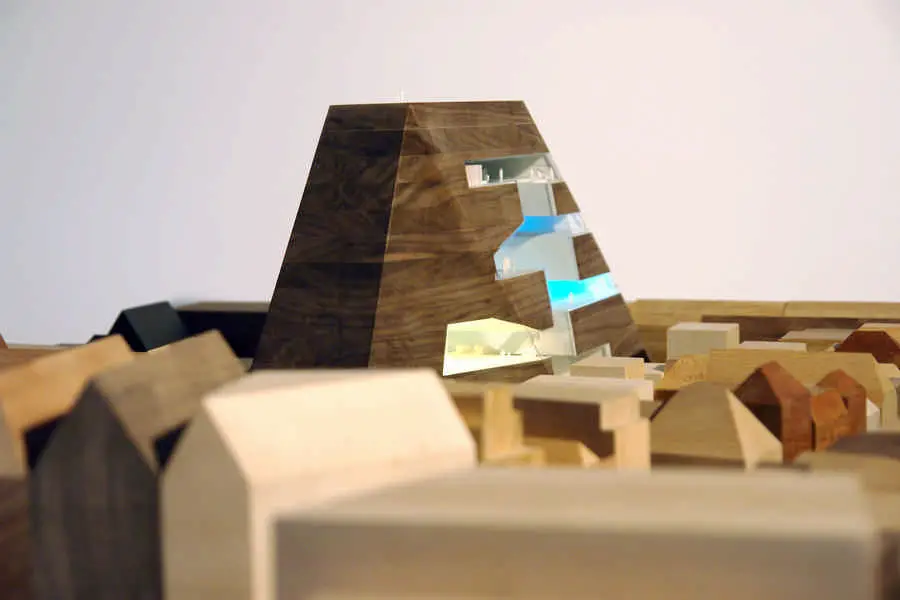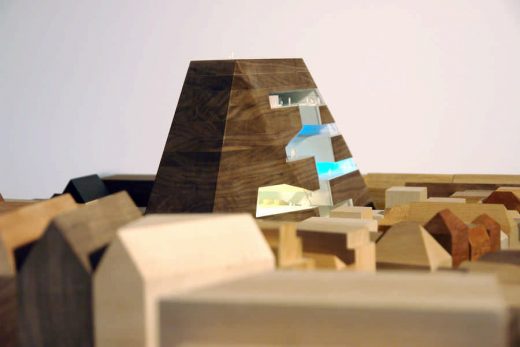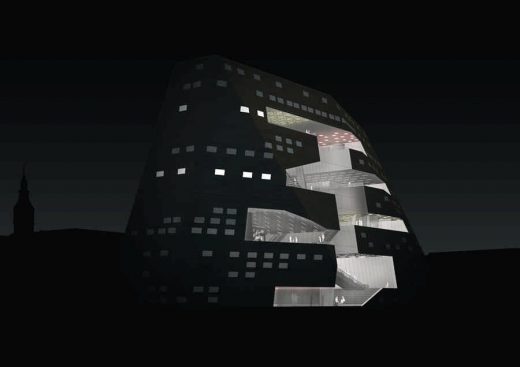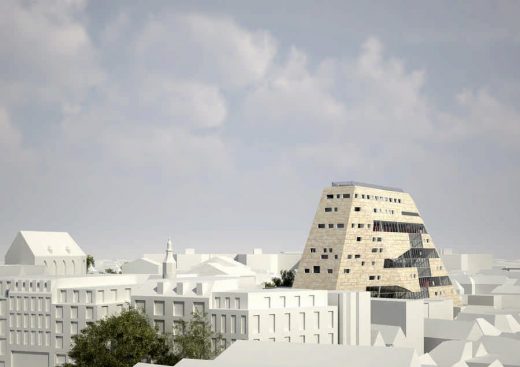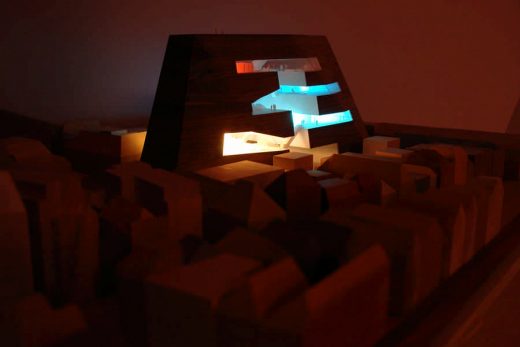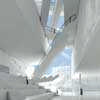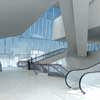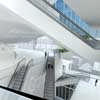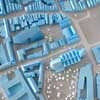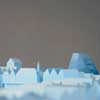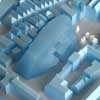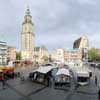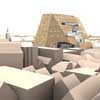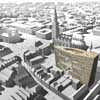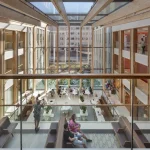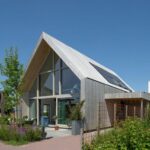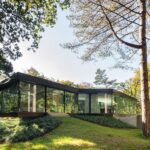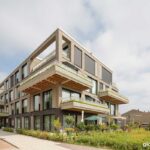Groninger Forum Building, NL Architects Holland, Groningen Architecture News, Dutch Design
Groninger Forum : Groningen Building
Architecture Development in The Netherlands – design by NL Architects
12 Sep 2011
Groninger Forum
Design: NL Architects
Groninger Forum Building
The Groninger Forum is probably one of the most exciting institutes to be constructed in the near future. Not so much because of its appearance, but because of its content. The Forum will become a platform for the exchange of information. It has the potential to become the physical equivalent of Wikipedia, both in terms of the level of public participation and the way in which links to related data will be made available. Different forms of information and different media will interconnect.
The Public Library Groningen, the Groninger Museum, Filmtheater Images and Regional Historic Center Groninger Archives/Groninger Audiovisual Archive, join forces to create a new type of public building. These four parties will collaborate with numerous cultural facilities to launch a center for debate and exchange; an amalgamation of museum, library, cinema and public square.
RFID technology makes it possible to rethink the organization of the library. A chip attached to an item will reveal its location: any new order becomes possible: alphabet soup.
Besides the ‘known’ functions that the building should accommodate, like the exhibition spaces, movie halls, auditorium and office spaces –the kind of spaces you can find in Neufert’s Architects’ Data- the building should also contain specific rooms dedicated to ‘exchange’. They will be thematically organized. Books, movies, sculptures, paintings, artifacts from the archives etc. will no longer be on display separately, in separate buildings, but will be brought together in the same space on the basis of shared content. As such they will reinforce each other.
The brief refers to these spaces as the Domains, but they could also be interpreted as ‘Squares’. They can vary from small to large and from permanent to temporary. There will be about 20 of them. Much of the terminology used in the virtual reality finds its origin in architecture. It is no surprise that the Forum reclaims some of these for the physical world.
The building is designed as one clear volume to express the collective ambition of combining different facilities into one new complex. Through a minimum of spatial operations the design aspires to generate a multitude of different appearances. The silhouette of the building is changing according to the position of the spectator. At one time slender and elegant, at the other large and wide, sometimes a leaning tower, sometimes almost a pyramid. As a starting point the maximum building volume is taken: an extrusion of the available site to the maximum height allowed by the zoning law.
The resulting block is tapered to loose superfluous volume and to appear less fat. It gets slimmer to the top. Fragments are sliced off to create light and air for the surroundings. Some cuts create distance to the adjacent buildings and some articulate the entrances. Slicing and tapering resolve a paradox: the entire volume reaches the maximum height of 45 meter, while miraculously meeting one of the other requirements of the urban plan: it does not exceed the average height of 33 meters.
The program is divided in public zones and restricted areas. For the cinema you need a ticket for example. A principle of alternating free and ‘ticketable’ areas orchestrates the accessibility. Scrambling these zones guarantees that every corner of the building will be open to everybody; the Forum will be as public as possible.
Parts of the program like to be transparent, communicative, open, where other parts require conditioned interiors, concentration and conservation. In the exhibition spaces for instance, daylight is not allowed, while much of the Domains can be extravert, offering visual relationships. The specific appearance of the building is derived from these open and closed fragments. The distinctive features emerge from the functional diagram.
The Atrium is the core of the Forum. Where you would expect the building to appear most massive it is opened-up by the central void. This transparent opening – the ‘pumping heart’ of the Groninger Forum – provides the connections between the different programs. Where a traditional atrium is just a vertical gap in a building, the Forum features horizontal extensions. They add programmatic capacity. Every floor allows spectacular views over the roofscape of Groningen.
Since the Forum is supposed to be engineered “to accommodate finding not searching” the design stimulates exploration. It hopes to catalyze the desire to wander through the building; to ‘browse’ through the artificial, stacked landscape. In a way the building is a vertical square. The activities inside the building are exposed, turning the Atrium into an animated logo for the vital character of the Groninger Forum. By introducing the hole the Forum might be able to help “Reconstruct the Whole”…
Groninger Forum – Building Information
Site: Nieuwe Markt, Groningen (The Netherlands)
Client: Municipality of Groningen
Program: Library, Museum, Cinema, Auditorium, Restaurant, Bars, Parking (cars and bikes)
Size: 20.000 m2 + Parking 15.000 m2 gross surface
Building Costs: 70 mn euro incl. installations / ex VAT
Design: 2007 (competition 1st prize)
Completion: 2015
Groninger Forum
Groninger Forum is a new type of public building; an innovative center for debate that aspires to blur the boundaries between Library, Museum and Cinema. A public ‘square’ winds up and makes all the ‘pores’ of the building accessible. The intelligent organization of open and closed functions creates an explicit figure: a 3D logo for the public character of the institute.
Groninger Forum images / information from NL Architects
Location: Groningen, Visit Netherlands
Architecture in The Netherlands
Contemporary Dutch Architecture
Netherlands Architecture Designs – chronological list
Amsterdam Architecture Walking Tours by e-architect
Dutch Architect – design firm listings
Groningen Buildings
Groningen Buildings Photographs
Groningen Architecture
Observation Tower, ‘De Onlanden’, Drenthe, near Groningen
Design: UNStudio
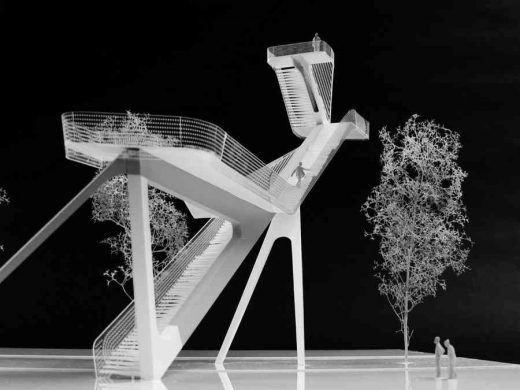
picture : UNStudio
Observation Tower
Education Executive Agency and Tax Offices in Groningen
Design: UNStudio, Architects
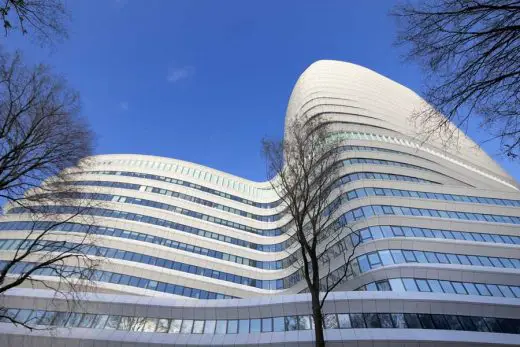
photo : Ronald Tilleman
IBG Building Groningen
New Martini Hospital
Design: Burger Grunstra architecten adviseurs
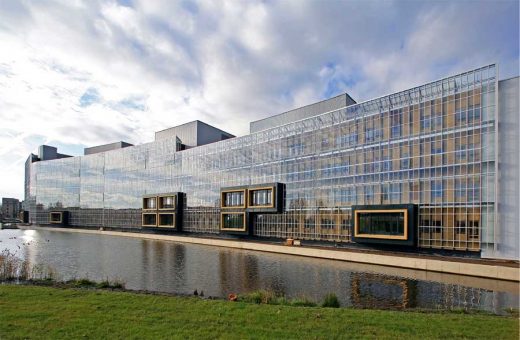
photograph : Rob Hoekstra
New Martini Hospital
Dutch Architecture – Selection
Almere Masterplan
Design: Rem Koolhaas, OMA
Almere Masterplan
Design: UNStudio
Theatre Agora
Design: MVRDV
WoZoCo Amsterdam
Comments / photos for this Groninger Forum page welcome

